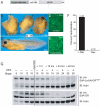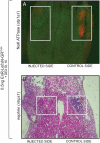Requirement of Wnt/beta-catenin signaling in pronephric kidney development
- PMID: 19100832
- PMCID: PMC2684468
- DOI: 10.1016/j.mod.2008.11.007
Requirement of Wnt/beta-catenin signaling in pronephric kidney development
Abstract
The pronephric kidney controls water and electrolyte balance during early fish and amphibian embryogenesis. Many Wnt signaling components have been implicated in kidney development. Specifically, in Xenopus pronephric development as well as the murine metanephroi, the secreted glycoprotein Wnt-4 has been shown to be essential for renal tubule formation. Despite the importance of Wnt signals in kidney organogenesis, little is known of the definitive downstream signaling pathway(s) that mediate their effects. Here we report that inhibition of Wnt/beta-catenin signaling within the pronephric field of Xenopus results in significant losses to kidney epithelial tubulogenesis with little or no effect on adjoining axis or somite development. We find that the requirement for Wnt/beta-catenin signaling extends throughout the pronephric primordium and is essential for the development of proximal and distal tubules of the pronephros as well as for the development of the duct and glomus. Although less pronounced than effects upon later pronephric tubule differentiation, inhibition of the Wnt/beta-catenin pathway decreased expression of early pronephric mesenchymal markers indicating it is also needed in early pronephric patterning. We find that upstream inhibition of Wnt/beta-catenin signals in zebrafish likewise reduces pronephric epithelial tubulogenesis. We also find that exogenous activation of Wnt/beta-catenin signaling within the Xenopus pronephric field results in significant tubulogenic losses. Together, we propose Wnt/beta-catenin signaling is required for pronephric tubule, duct and glomus formation in Xenopus laevis, and this requirement is conserved in zebrafish pronephric tubule formation.
Figures









Similar articles
-
Essential function of Wnt-4 for tubulogenesis in the Xenopus pronephric kidney.Dev Biol. 2002 Aug 1;248(1):13-28. doi: 10.1006/dbio.2002.0712. Dev Biol. 2002. PMID: 12142017
-
Pronephric tubulogenesis requires Daam1-mediated planar cell polarity signaling.J Am Soc Nephrol. 2011 Sep;22(9):1654-64. doi: 10.1681/ASN.2010101086. Epub 2011 Jul 29. J Am Soc Nephrol. 2011. PMID: 21804089 Free PMC article.
-
Patterning the embryonic kidney: BMP signaling mediates the differentiation of the pronephric tubules and duct in Xenopus laevis.Dev Dyn. 2008 Jan;237(1):132-44. doi: 10.1002/dvdy.21387. Dev Dyn. 2008. PMID: 18069689
-
Towards a molecular anatomy of the Xenopus pronephric kidney.Int J Dev Biol. 1999;43(5):381-95. Int J Dev Biol. 1999. PMID: 10535314 Review.
-
WNT/beta-catenin signaling in nephron progenitors and their epithelial progeny.Kidney Int. 2008 Oct;74(8):1004-8. doi: 10.1038/ki.2008.322. Epub 2008 Jul 16. Kidney Int. 2008. PMID: 18633347 Free PMC article. Review.
Cited by
-
Peroxiredoxin1, a novel regulator of pronephros development, influences retinoic acid and Wnt signaling by controlling ROS levels.Sci Rep. 2017 Aug 21;7(1):8874. doi: 10.1038/s41598-017-09262-6. Sci Rep. 2017. PMID: 28827763 Free PMC article.
-
The enpp4 ectonucleotidase regulates kidney patterning signalling networks in Xenopus embryos.Commun Biol. 2021 Oct 7;4(1):1158. doi: 10.1038/s42003-021-02688-9. Commun Biol. 2021. PMID: 34620987 Free PMC article.
-
Renal hypodysplasia associates with a WNT4 variant that causes aberrant canonical WNT signaling.J Am Soc Nephrol. 2013 Mar;24(4):550-8. doi: 10.1681/ASN.2012010097. Epub 2013 Mar 21. J Am Soc Nephrol. 2013. PMID: 23520208 Free PMC article.
-
Renoprotective effect of erythropoietin in zebrafish after administration of gentamicin: an immunohistochemical study for β-catenin and c-kit expression.J Nephrol. 2017 Jun;30(3):385-391. doi: 10.1007/s40620-016-0353-y. Epub 2016 Sep 27. J Nephrol. 2017. PMID: 27679401
-
Gpr48 deficiency induces polycystic kidney lesions and renal fibrosis in mice by activating Wnt signal pathway.PLoS One. 2014 Mar 3;9(3):e89835. doi: 10.1371/journal.pone.0089835. eCollection 2014. PLoS One. 2014. PMID: 24595031 Free PMC article.
References
-
- Aulehla A, Herrmann BG. Segmentation in vertebrates: clock and gradient finally joined. Genes Dev. 2004;18:2060–7. - PubMed
-
- Benzing T, Simons M, Walz G. Wnt signaling in polycystic kidney disease. J Am Soc Nephrol. 2007;18:1389–98. - PubMed
-
- Brandli AW. Towards a molecular anatomy of the Xenopus pronephric kidney. Int J Dev Biol. 1999;43:381–95. - PubMed
-
- Brembeck FH, Rosario M, Birchmeier W. Balancing cell adhesion and Wnt signaling, the key role of beta-catenin. Curr Opin Genet Dev. 2006;16:51–9. - PubMed
-
- Bridgewater D, Cox B, Cain J, Lau A, Athaide V, Gill PS, Kuure S, Sainio K, Rosenblum ND. Canonical WNT/beta-catenin signaling is required for ureteric branching. Dev Biol. 2008;317:83–94. - PubMed
Publication types
MeSH terms
Substances
Grants and funding
LinkOut - more resources
Full Text Sources
Molecular Biology Databases

